Dates for your Diary
14th to 16th April 2022 – Easter Egg Hunt, 50p per person
Museum opening times
The Museum is open to the public, free of charge:
Thursday* to Saturday 10am – 1pm
March 100 Club
This month’s prize numbers were drawn by members Val Rosser and Gaynor Tucker and the lucky winners are:-
No. 68 Lucy Harding £20
No. 49 Greg York £10
If you would like to join our 100 club and be in with a chance of winning, it costs just £1 a month. Ask at the museum for further details.
Donation
Many thanks to our President, Mr Jack Hanbury, for his very kind and generous donation of £100.
Thora Silverthorn 1910-1999
Last month I reported on the Purple Plaque soon to adorn the outside of Abertillery Museum but didn’t mention the name; well I can now reveal that the mystery woman being honoured is Thora Silverthorn. Thora was born in Abertillery to Sarah Boyt and miner, George Silverthorne. When her mother died in 1927 the family relocated to Reading. At the age of 16 Thora joined the British Communist Party of which she was a life-long member. She was a one-time Labour MP for Reading but she was also a trained nurse who was instrumental in the formation of both the NHS and of the very first union for rank and file nurses. The plaque in her honour will be unveiled at a ceremony on 13th May. To learn more about the remarkable life of this woman use this link
Garden Festival Coffee Morning
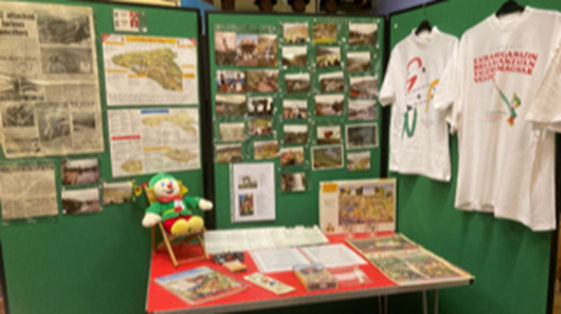

Our recent coffee morning was well attended and everyone seemed to enjoy the walk down memory lane with our hour-long video.
The exhibition of Garden Festival memorabilia will be ending soon so don’t miss your chance to see it!
Youth Hostels
Have any of our readers tried youth hostelling? My husband and I first went hostelling in this country in our late twenties – no longer youths and with two young children in tow. Youth hostelling was pretty basic but it was cheap and enabled us to get away for more short holidays than would otherwise have been possible. Many decades later and we still occasionally go to a Youth Hostel (what a misnomer) on walking weekends with our walking group, often booking the whole hostel and often staying in buildings with a history from old railway stations to former hotels. The best of the latter group has to be the hostel at The Lizard in Cornwall, sadly now being sold. A former hotel it stands above the cliffs with magnificent views out to sea and right on the coastal path. The only possible downside is that it also stands alongside the lighthouse and its foghorn which goes off not infrequently!
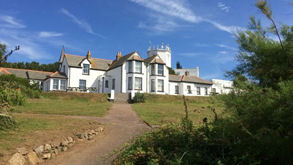
Above the hostel at The Lizard which stands next to a lighthouse (see below):

How did the Youth Hostel Association start? Well it really started in Germany where the first hostel opened in 1909 and twenty years later a small group of interested people established Britain's first hostel with many more to follow when the national organisation was set up in 1930. This was the time of the Depression and hostels provided affordable accommodation and a chance for families (assuming they could afford the modest fees) to get away and enjoy some leisure time in fresh air and countryside.
Things changed of course over the years. At one time you were supposed to arrive on foot or on the bus if there was one, but it gradually became acceptable to arrive in a car and this is how most people arrive these days.
My very first experience of hostelling was back in 1967 when a friend and I went to Germany on holiday and could only afford youth hostels. My goodness were they strictly run! Doors locked and lights out at a set time in the evening, up early in the morning. I remember that at the hostel in Mainz a particularly strict warden was in charge and a bugle would sound in the mornings followed by her banging on the doors – none of your 'Morning Campers' a la Butlins! We also had sausages in various forms pretty well every day but we didn't mind that, the meals were cheap and filling.
Fast forward to our early hostel trips in this country – much more free and easy but you had to do 'jobs' before checking out, such as sweeping the common room or general tidying up, nothing too onerous but I was very glad when times changed and 'jobs ' were done away with and some en-suite rooms started being introduced. You are also now allowed to drink alcohol on the premises, that was out of the question in the seventies but there were more country pubs around in those days.
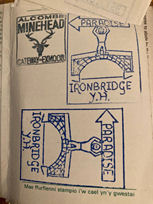 One thing which still persists (I believe) but not many people do it, is to collect hostel ‘stamps’.
One thing which still persists (I believe) but not many people do it, is to collect hostel ‘stamps’.
When we joined the organisation your membership book contained a number of blank pages for your hostel visit to be marked by a stamp and our children loved collecting the different ones.
If you have any memories of youth hostelling it would be good to hear them. Meantime here is a photo of the lovely hostel at the Lizard, the lighthouse next door and a page from my membership book showing some of the hostel stamps we collected.
Jen Price
Crumlin Viaduct
Every so often, to check that we are looking after our exhibits in the correct manner, the museum is inspected by a ‘Conservator’. One such inspection took place last month and it threw up a surprising find. The Conservator was not happy with a framed piece of tapestry that was on display; it was showing signs of decay and so was removed from its frame for further inspection and not only did we discover embroidery on the back of the tapestry that we weren’t aware of but hidden behind the tapestry was this beautiful framed photo of Crumlin Viaduct (see below), which inspired me to find out more about this impressive bridge…
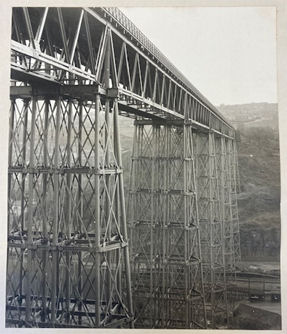
The photo was hidden behind a tapestry
A viaduct is a type of bridge, consisting of arches or columns to support a long stretch of road or railway and this viaduct was built to carry trains over the river Ebbw at Crumlin, South Wales. The twin-track bridge would not only carry passengers but also cargo, in particular coal and steel.
The tender to build this cast iron bridge was won by Scottish civil engineer Thomas W Kennard and construction began in October 1853. By May 1857 it was ready for testing and a train was loaded with 370 tons of pig iron with train driver ‘Mad Max’ of Pontypool charged with driving the train across the viaduct. He was told to drive slowly over the bridge, but Max, who had, it is said, visited every pub in Crumlin earlier that day, drove at speed over the bridge much to the annoyance of inspector Colonel Wynne of the Board of Trade who was watching below. It is said he later told Colonel Wynne that ‘when eternity looks you straight in the face, you may as well go full speed to meet it’.
Fortunately it passed its safety checks and the bridge was duly opened on 1st June 1857 by Lady Isabella Fitzmaurice. It stood 200 feet tall, 1650 feet long and was supported by ten trusses. It was the 3rd highest railway viaduct in the world and the highest in the UK, a record it held throughout its existence. Due to its height and location though it was susceptible to the weather especially wind which caused it to sway and this meant it needed constant, expensive maintenance. Indeed it was one of the most expensive routes to run and, to keep costs down and for safety reasons, it was reduced to a single track from 1947.
By the 1960s, railways were coming under increasing competition from road freight and in 1964 it was decided to close this stretch or railway. It was hoped to preserve the bridge as a site of historic interest but it proved to be in too poor a state. The last passenger train to pass over the bridge was the 21:10 from Pontypool to Treherbert on 13th June 1964.
In June 1966 demolition of the bridge began but not before it was used in the making of a film! The 1966 film Arabesque starring Gregory Peck and Sophie Lauren shows this iconic pair running along the maintenance shaft, underneath the railway line, while being pursued by the ‘villains’ in a helicopter. And, not only was a young yours truly there watching the filming, but my late father, Tom Wayne, actually captured it on his Super 8 Cine camera and the 30 second video clip is now available to view on the museum’s Facebook page.
Today, all that remains of the viaduct are the two stone supports at each end. As for the tapestry with its hidden photo, there is more on this on page four.
Sally Murphy
For more information on Crumlin Viaduct, use this link
Easter Bonnets
Not so popular these days but where does the tradition of the Easter bonnet come from?
ome people will think it came from the very popular film by Irving Berlin – Easter Parade, where the ladies all dressed in the very best would parade down Fifth Avenue in New York, but there is the reference of an Easter suit as far back as Shakespearean times when in, Romeo and Juliet, there is a reference to an Easter suit!
In the USA it is thought that after the Civil war ladies stepped out of church with more positive attitudes to life and would dress up for church at Easter. Each year it gained popularity and eventually the Fifth Avenue Parade was born.
Others think the tradition may originate in the Christian faith so after the fasting of Lent, the happiness and belief of new life would encourage the wearing of your Sunday best to church, and at Easter it had to be your ‘very Best Sunday Best’! Easter is the religious time of rebirth/resurrection and a hat whether new or refurbished felt like a luxury to be shown off at Easter services as a sign of spiritual renewal or redemption.
It is unclear if ‘bonnet’ is a generic use for any hat or a specific style that was more popular at the time when ladies usually wore some kind of head covering to keep their hair in place and free from dust and such….heavier during the colder months but then, with the arrival of spring, out would come the lighter hats (new bonnet) tied under the chin to keep in place.
The Easter Bonnet is not such a popular thing these days with the more casual society, but it is still quite popular with younger children’s learning classes where children are encouraged to decorate a bonnet/hat with ribbons, bows, flowers, bunnies and any springtime accessory or motif. Of course the ‘Easter Egg’ tradition continues with the symbol of new life represented by the egg – it is a big money spinner for all commercial outlets...and of course children love chocolate!!
Karen Pratley
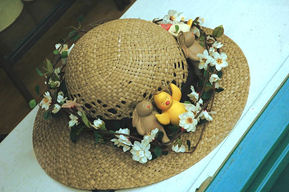
By Wendy Slattery - originally posted to Flickr as Easter Bonnet, CC BY 2.0
Mystery Tapestry
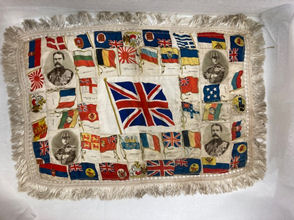
Above is the tapestry referred to on page three the frame of which had been hiding the photo of Crumlin viaduct. It had been standing on the table alongside the children’s sand pit, propped up against a cupboard. But it also had another secret, on its reverse side, hidden from view, was yet more embroidery (see photo below). The tapestry has not been catalogued and we have no idea where it came from though we think it dates to before 1997. If you recognise it, please get in touch.
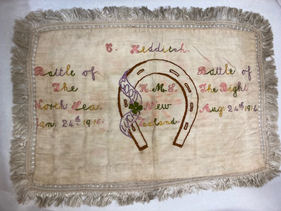
Top Of Page
